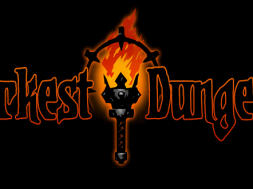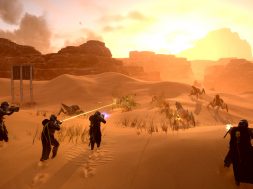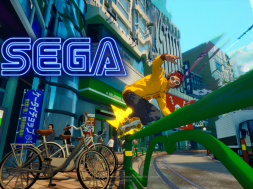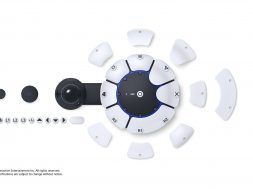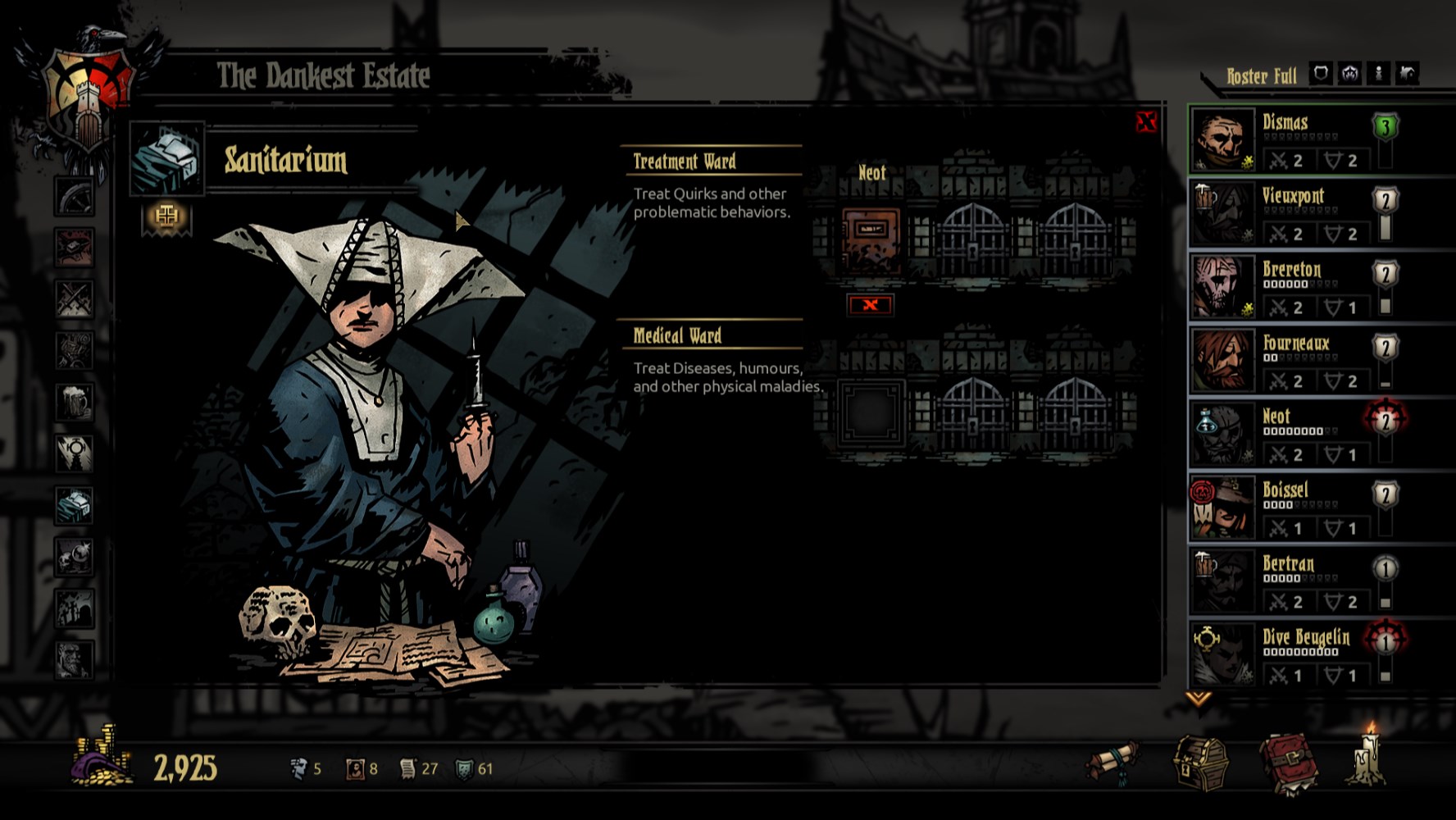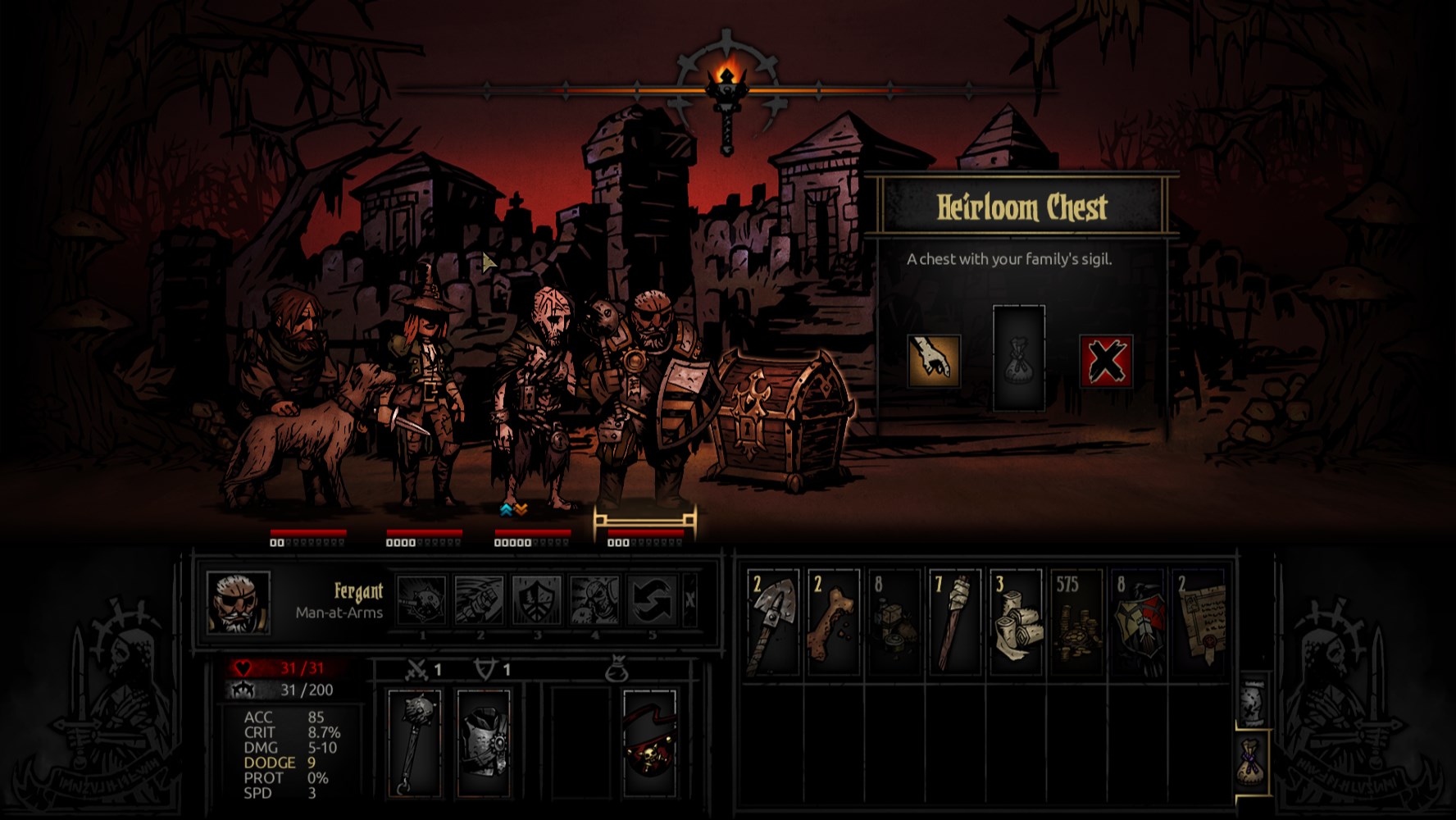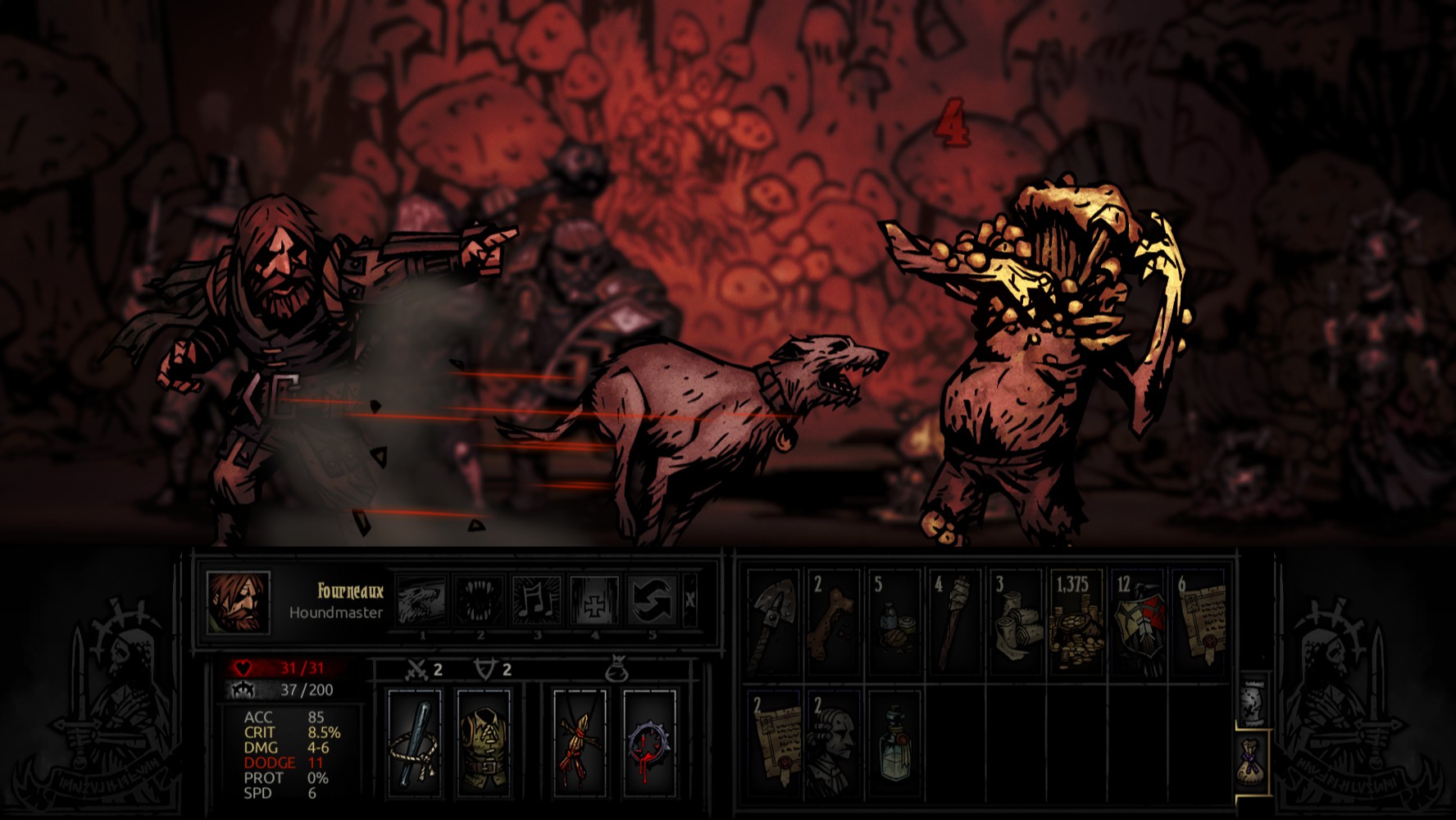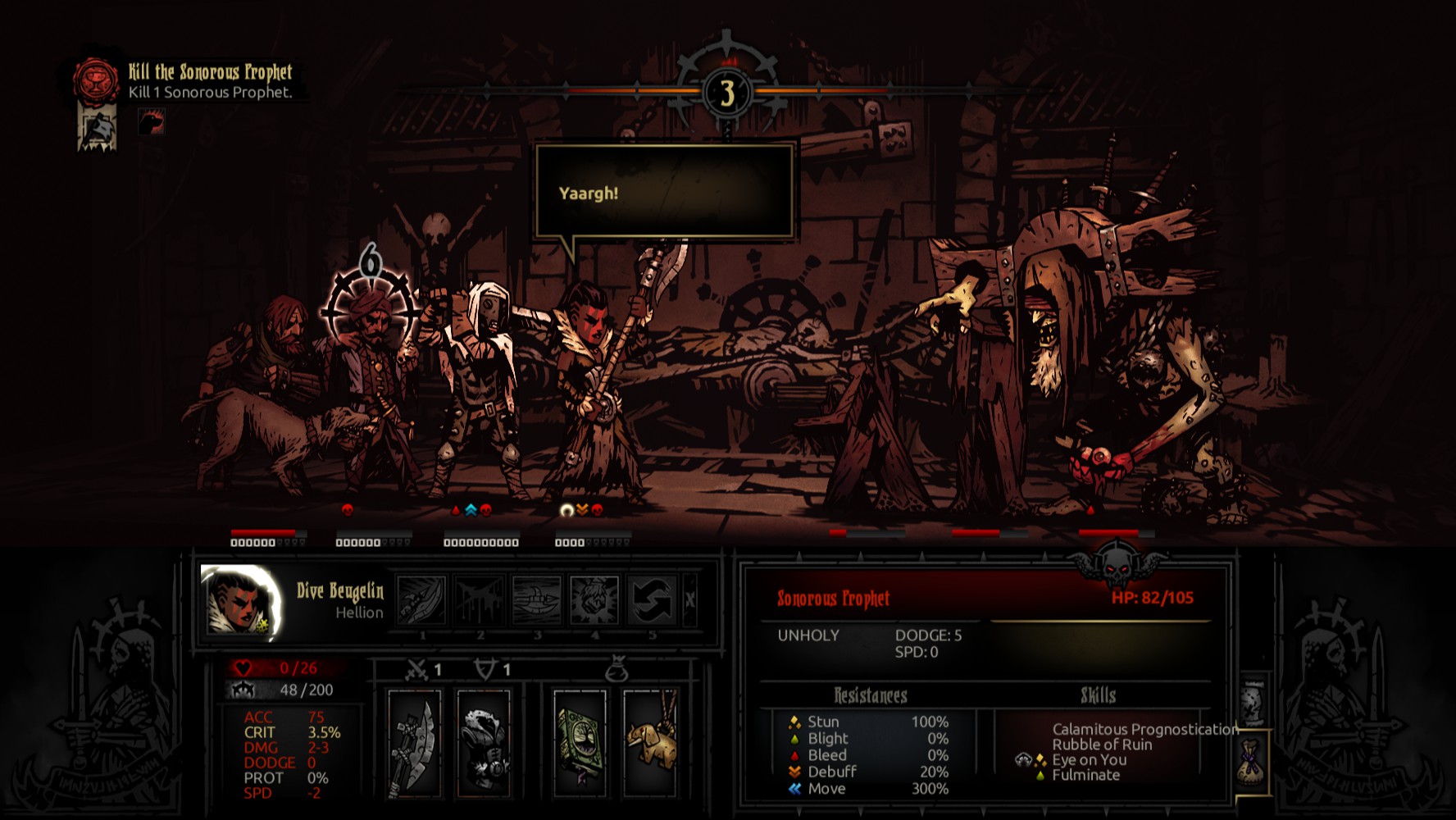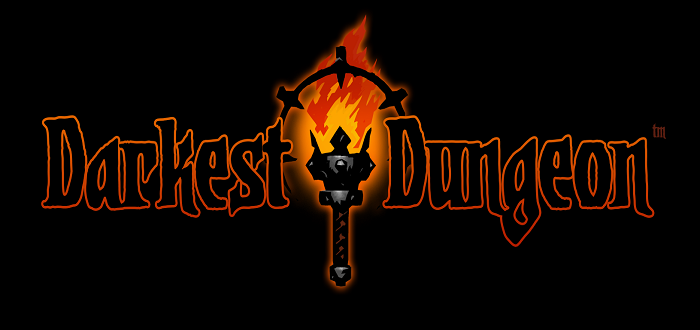
Let me paint you a picture to show you the emotions this game can cause before we jump into the review. In the darkest hours of the night, I was on my last nerve with this game. In what seemed like an endless battle between eldtrich beings and a team of adventurers, all on their last leg, the last two of four bleeding out, I was ready for this dungeon to end. Then a gross fish monster gained a critical slash on my werewolf and my last warrior died from a heart attack. I slammed my fist down and screamed into my desk. Believe it or not, I was having so much fun.
Developed by newcomer indie studio, Red Hook Studios, Darkest Dungeon is a rare example of a Kickstarter and Steam Greenlight success story. Clearing its Kickstarter goals, the game became available around a year ago on Steam Greenlight. A steady stream of updates has led to this the full release, a game infuriatingly worth the wait.
Darkest Dungeon begins with a fantastic animation recapping the history of an elderly old man who once lived in a magnificent cliff-side mansion. The man spent his days locked in his chambers, spending his great fortune on all seven of the deadly sins. One day he began to delve into dark magic and discovered that underneath the manor was a large door, holding a secret of untold power. Upon opening the door, that power was released, but the power was actually a portal to another realm, releasing hundreds of demons into ours. The manor was lost, overrun with evil, and over time turning it into what we now know as the Darkest Dungeon.
It is up to a group of heroes to take back what is yours from the darkness and reclaim the manor. While the set-up may be simple, the presentation and narration are expertly told, adding a surprisingly deep layer of lore to an already interesting world, complete with audio narration from the old man, describing the monsters he came in contact with and his past adventures.
How I would describe Darkest Dungeon in gameplay terms would be a survival horror turn-based RPG. The game has two major systems that make up a gameplay loop that drives you to keep playing; a town-based management and upgrade system and dungeon spelunking. The two systems work as a symbiotic relationship as you need money to upgrade, but you get money from dungeons, and you need to upgrade to get through tougher dungeons.
The town is made up of a series of buildings (Tavern, Blacksmith, Guild Hall, Stagecoach, Abbey, Survivalist, Sanitarium and Nomad Wagon). These buildings are used in different ways, as the Tavern and Abbey are used to reduce stress, a status effect that occurs from running dungeons and can cause heart attacks in combat. The blacksmith and guild hall upgrade your heroes’ moves and equipment. The stagecoach is where you enlist new adventurers, survivalist is used to improve camping traits, sanitarium is used to get rid of negative status effects and the nomad wagon is used to buy rare items.
All of these buildings can be upgraded with money, some upgrades being price drops or more weapon upgrades. These buildings are upgraded through artefacts (busts, portraits, deeds and crests), which are items found in dungeons. Now if this all sounds a little complicated, that is because it is. There is always so much to upgrade and keep track of in the hamlet, and you will start to feel a little overwhelmed. This is a good thing. After time, you will get used to the constant checklist of things you need to do and pay for in town, and it all works exactly how you think it would, though the UI systems can be a little cluttered at times.
The second gameplay element comes in with the dungeon exploring. Before heading out into a dungeon, you must pick four adventurers from a list of 14 distinct classes. These classes can range from a typical mage healer to a dog carrying houndmaster. You must sort these adventurers into an order of four slots, which can change how each character plays drastically. For example, a houndmaster works well in the back (slot number four) as he can send his dog out to attack from the back, while a crusader can only slash and attack from slot one and two.
Placement of your heroes is a massive element of combat, as a single misplaced character could mean they can’t even shoot their gun. Before you head out, however, you can equip your adventurers with special trinkets that act as buffs, some of which are character class-specific. You also have to stock up on supplies for your journey; these items range from torches (necessary to light your way) to food (used to heal and feed your troops). These items aren’t really a choice, they are integral to surviving in a dungeon because if it gets dark, enemies get a buff and your stress is higher.
While all of these things are important for a successful dungeon run, the game doesn’t stop you from simply ignoring them and going into a dungeon unprepared. There are no ‘Are you sure?’ options or tutorial hints. The game simply gives you the option of a high risk reward dungeon run with no equipment, and the freedom to do whatever you want in these dungeons adds a lot of depth to the item management screens, if you can actually remember everything.
When you’re all packed up with supplies and you’ve sorted your team’s placement and equipment, then it is time to head into one of five locations: the Warrens, Ruins, Cove, Weald and the game’s last location, the Darkest Dungeon. Each location has different negatives and positives, like the Ruins being infested with skeletal enemies, meaning characters who have attacks that cause bleed effects are useless due to skeletons not bleeding. Knowing which characters to bring to a location is where a lot of the game’s hidden depth comes into play as some characters work better with others and in certain locations. For example, the occultist works better in the cove, as it is filled with eldtrich beings.
When you actually get into a dungeon, the game plays like a 2D dungeon crawler, complete with chests, secret rooms and, of course, evil beings to battle. The combat works in a turn based scenario, with the order of attacks working with an RNG (random number generator), meaning you don’t know if your characters or the enemy will attack next. This random nature adds a lot of tension to fights, meaning you will need to rely on status effects like poison and bleeding to affect the enemy over time. The game’s combat itself is fairly simple; it’s turn-based with added RNG to turns, using minimal animation to great effect which adds a surprising level of impact to hits.
Speaking of status effects, the game also includes a system called ‘Quirks’, which are permanent effects that adventurers can achieve from high stress levels or random number levels. These ailments are split into positive and negative effects, examples of a negative quirk being masochistic tendencies, meaning the character will not be healed and can be buffed from attacks. A positive quirk would be evasive, adding a 5+ to all dodges. Heroes can also get diseases from battle, such as black plague, which adds a -75 blight resist. These diseases can be healed at the Sanitarium, but for a high price.
Visually, Darkest Dungeon nails its oppressive and downright grotesque aesthetic perfectly. Blending a mix of dark medieval and lovecraftian horror creates a horrifying, sometimes beautiful and sombre world filled to the brim with twisted creatures that want your blood. And I can’t not point how incredibly strong the monster design is in Darkest Dungeon, especially some of the more out-there eldritch monstrosities that come your way. The same can be said for the game’s audio design, as every hit and blood splat is expertly crafted, giving a real sense of power to attacks and movements. The soundtrack is solid, but nothing really to write home about, though it still fits the dark and oppressive tone the game is going for.
Darkest Dungeon is an evil game. While the Souls series is more popularly known for extremely difficult gameplay and boss fights, at least they are designed to be fair. Darkest Dungeon on the other hand doesn’t care about being fair, it cares about killing you, and I love it for that. It, however, does not love me, and this abusive relationship of upgrading and dungeon crawling makes Darkest Dungeon a perfect spike-covered, bleeding package.
Darkest Dungeon is available for purchase on PC with a PS4 and PS Vita release coming in Spring.
